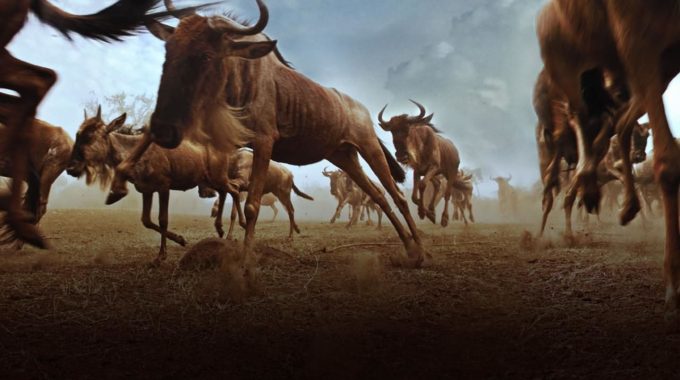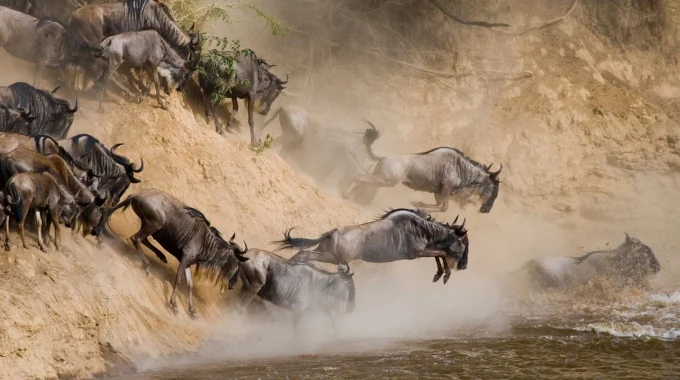How fast do wildebeest reproduce? - Wildebeests (Connochaetes spp.) are iconic members of the African savannas…
Where is the great wildebeest migration?
Where is the great wildebeest migration? – The Great Wildebeest Migration is a natural event that takes place across the Serengeti-Mara ecosystem, spanning northern Tanzania and southern Kenya. The migration involves the movement of over 1.5 million wildebeests, along with hundreds of thousands of zebras, gazelles, and other herbivores, as they move in search of fresh grazing and water.

The Main Locations of the Great Migration:
The migration primarily occurs between the Serengeti National Park in Tanzania and the Maasai Mara National Reserve in Kenya, following a seasonal pattern. The animals move through different parts of this ecosystem based on the availability of fresh grass, driven by the rains and the seasonal changes in the environment.
-
Southern Serengeti (Tanzania)
- Location: The southern Serengeti is the starting point of the migration and where the wildebeest give birth during the calving season (usually January to March). The area around Ndutu and Ngorongoro Conservation Area is where the herds gather in large numbers to give birth to their calves.
- When to Visit: January to March is the best time to visit the southern Serengeti to see the calving season. During this period, over half a million calves are born, and predators are abundant, creating intense wildlife action.
-
Central Serengeti (Tanzania)
- Location: After the calving season, the wildebeests and other herbivores move northward across the central Serengeti. This area is lush and green during the wet season, but the herds move on as they seek better grazing areas in the north.
- When to Visit: April to May is when the herds move through central Serengeti, heading toward the western and northern Serengeti regions in search of fresh grass.
-
Western Serengeti (Tanzania)
- Location: The western Serengeti is where the wildebeests face their first major challenge of the migration: crossing the Grumeti River. The river is filled with crocodiles, and this crossing can be dramatic, though it is not as famous as the Mara River crossing in Kenya.
- When to Visit: June to July is when the wildebeests typically cross the Grumeti River and begin heading toward the northern Serengeti. The herds are now in the western Serengeti, and the migration action intensifies.
-
Northern Serengeti (Tanzania)
- Location: The wildebeests reach the northern Serengeti around July to October. This is where the Mara River (which forms the border between Tanzania and Kenya) comes into play. The herds face the Mara River crossings, which are some of the most dramatic and iconic moments of the migration.
- When to Visit: July to October is the best time to visit the northern Serengeti to witness the Mara River crossings, where wildebeests must cross the river, often under the threat of crocodile attacks and predators waiting on the banks.
-
Maasai Mara (Kenya)
- Location: After crossing the Mara River, the wildebeests enter the Maasai Mara in Kenya. The Mara has lush grasslands during the dry season, and it is a prime location for the herds to graze before returning south to Tanzania in the wet season.
- When to Visit: July to October is the peak time to visit the Maasai Mara, when the herds are in the area, crossing the Mara River and grazing in the rich grasslands of the Mara. This is also when predator activity is high, as lions, cheetahs, and hyenas follow the herds.
-
Return to Southern Serengeti (Tanzania)
- Location: After spending the dry season in the Maasai Mara, the wildebeests and other herbivores start to head back south, usually around October to December, following the rains and fresh grass. They return to the southern Serengeti to start the cycle again.
- When to Visit: October to December is the return phase, as the herds start their journey south to the Serengeti’s southern plains.
Seasonal Movement Pattern of the Great Migration
- January to March (Southern Serengeti): The wildebeests give birth in the southern Serengeti, particularly around Ndutu and the Ngorongoro Conservation Area.
- April to May (Central Serengeti): The herds start moving northward through the Serengeti towards the western corridor.
- June to July (Western Serengeti): The wildebeests cross the Grumeti River in western Serengeti before heading north.
- July to October (Northern Serengeti & Maasai Mara): The herds reach the northern Serengeti and attempt the Mara River crossings into the Maasai Mara, Kenya.
- October to December (Return to Southern Serengeti): After spending time in Kenya, the herds move back south to the southern Serengeti for the start of the next cycle.
Where to See the Migration at Its Best
- Tanzania: The best places to see the Great Migration in Tanzania are:
- Southern Serengeti (January to March): For calving season and predator-prey action.
- Western Serengeti (June to July): For the Grumeti River crossing.
- Northern Serengeti (July to October): For the Mara River crossings.
- Kenya: The best time to see the migration in Kenya is in the Maasai Mara from July to October, when the wildebeests have crossed the Mara River from Tanzania and are grazing in the rich grasslands of the Mara.
Summary
The Great Wildebeest Migration occurs across the Serengeti-Mara ecosystem, which spans parts of northern Tanzania and southern Kenya. The migration follows a seasonal route:
- Southern Serengeti (Tanzania) during calving season (January to March).
- Western Serengeti (Tanzania) for Grumeti River crossings (June to July).
- Northern Serengeti (Tanzania) and Maasai Mara (Kenya) for the Mara River crossings (July to October).
- Return to Southern Serengeti (Tanzania) around October to December.
The best time to witness the migration is from July to October, when the herds are crossing the Mara River and are in the Maasai Mara and northern Serengeti.



